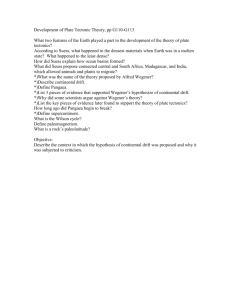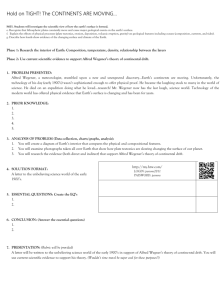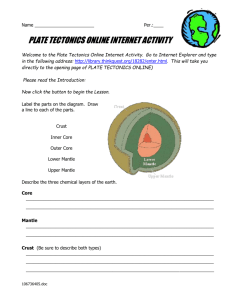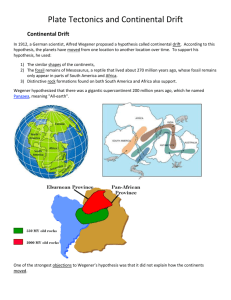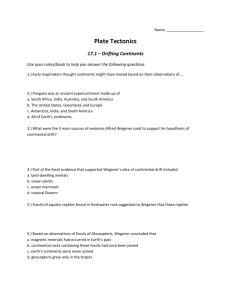Wegener's 'Continental drift' meets Wilson's 'Plate tectonics' (ELI+)
advertisement
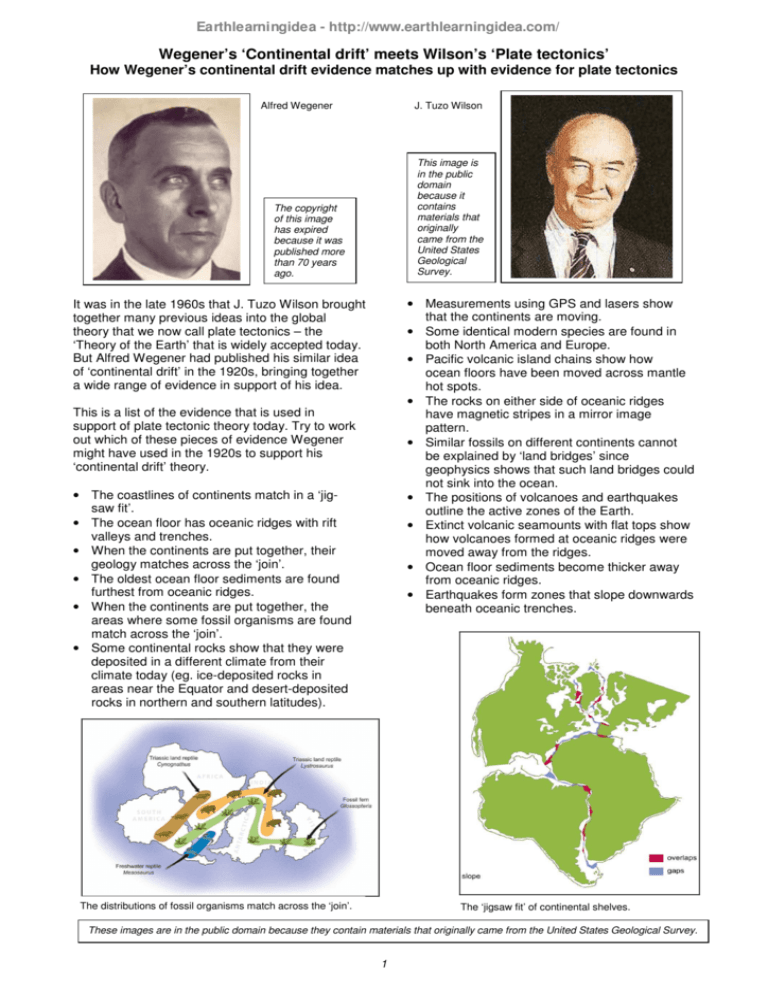
Earthlearningidea - http://www.earthlearningidea.com/ Wegener’s ‘Continental drift’ meets Wilson’s ‘Plate tectonics’ How Wegener’s continental drift evidence matches up with evidence for plate tectonics Alfred Wegener J. Tuzo Wilson This image is in the public domain because it contains materials that originally came from the United States Geological Survey. The copyright of this image has expired because it was published more than 70 years ago. • Measurements using GPS and lasers show that the continents are moving. • Some identical modern species are found in both North America and Europe. • Pacific volcanic island chains show how ocean floors have been moved across mantle hot spots. • The rocks on either side of oceanic ridges have magnetic stripes in a mirror image pattern. • Similar fossils on different continents cannot be explained by ‘land bridges’ since geophysics shows that such land bridges could not sink into the ocean. • The positions of volcanoes and earthquakes outline the active zones of the Earth. • Extinct volcanic seamounts with flat tops show how volcanoes formed at oceanic ridges were moved away from the ridges. • Ocean floor sediments become thicker away from oceanic ridges. • Earthquakes form zones that slope downwards beneath oceanic trenches. It was in the late 1960s that J. Tuzo Wilson brought together many previous ideas into the global theory that we now call plate tectonics – the ‘Theory of the Earth’ that is widely accepted today. But Alfred Wegener had published his similar idea of ‘continental drift’ in the 1920s, bringing together a wide range of evidence in support of his idea. This is a list of the evidence that is used in support of plate tectonic theory today. Try to work out which of these pieces of evidence Wegener might have used in the 1920s to support his ‘continental drift’ theory. • The coastlines of continents match in a ‘jigsaw fit’. • The ocean floor has oceanic ridges with rift valleys and trenches. • When the continents are put together, their geology matches across the ‘join’. • The oldest ocean floor sediments are found furthest from oceanic ridges. • When the continents are put together, the areas where some fossil organisms are found match across the ‘join’. • Some continental rocks show that they were deposited in a different climate from their climate today (eg. ice-deposited rocks in areas near the Equator and desert-deposited rocks in northern and southern latitudes). The distributions of fossil organisms match across the ‘join’. The ‘jigsaw fit’ of continental shelves. These images are in the public domain because they contain materials that originally came from the United States Geological Survey. 1 Earthlearningidea - http://www.earthlearningidea.com/ The back up • Pacific volcanic island chains show how ocean floors have been moved across mantle hot spots – first described by J. Tuzo Wilson in the 1960s. • The rocks on either side of oceanic ridges have magnetic stripes in a mirror image pattern – first described by Vine and Matthews in the early 1960s • Extinct volcanic seamounts with flat tops show how volcanoes formed at oceanic ridges were moved away from the ridges - the seamounts were only discovered in the 1950/60s when echo sounders were used to map the ocean floors. • Ocean floor sediments become thicker away from oceanic ridges – this evidence only became available when seismic methods were used to measure the thicknesses of sediments. • Earthquakes form zones that slope downwards beneath oceanic trenches – only plotted by Benioff and Waditi in the 1940/50s. Title: Wegener’s ‘Continental drift’ meets Wilson’s ‘Plate tectonics’. Subtitle: How Wegener’s continental drift evidence matches up with evidence for plate tectonics. Topic: Sorting out which parts of the evidence we now have for plate tectonics that Alfred Wegener knew about in the 1920s. Age range of pupils: 14 – 18 years. Time needed to complete activity: 15 mins. Pupil learning outcomes: Pupils can: • describe the evidence we have for plate tectonic theory today; • describe the evidence that Wegener used for his ‘Continental drift’ theory; • discuss why Wegener’s evidence might not have been believed at the time. Following up the activity: Ask the class to discuss why, when so much good evidence for the movement of continents was published by Wegener, his ‘continental drift’ theory was not believed at the time. They may note: a) that in the 1920s most geologists thought the Earth’s activity and geology could be explained by vertical movements of parts of the Earth and not by horizontal movements; b) Wegener was a meteorologist and not a geologist; c) Wegener published his work in German, which was not understood in most parts of the world (his work was translated into English later); d) Wegener’s work included an error in calculating the movement of Greenland from measurements of longitude; e) Wegener could not explain a process that could move continents, the forces he suggested were only very weak forces; f) geologists said that the continents were not strong enough to move laterally (they were correct, the continents can only be moved as part of much thicker plates of lithosphere). Context: The lists below show which evidence was available to Wegener and which was not. Evidence described by Wegener (1920s) (his own evidence together with the evidence of others) • The coastlines of continents match in a ‘jig-saw fit’. • When the continents are put together, their geology matches across the ‘join’. • When the continents are put together, the areas where some fossil organisms are found match across the ‘join’. • Some continental rocks show that they were deposited in a different climate from their climate today (eg. ice-deposited rocks in areas near the Equator and desert-deposited rocks in northern and southern latitudes). • Some identical modern species are found in both North America and Europe. • Similar fossils on different continents cannot be explained by ‘land bridges’ since geophysics shows that such land bridges could not sink into the ocean. • The positions of volcanoes and earthquakes outline the active zones of the Earth. Evidence not available to Wegener (note – some of the dates below are approximate) • The ocean floor has oceanic ridges with rift valleys and trenches – only discovered in the 1950/60s when echo sounders were used to map the ocean floors. • The oldest ocean floor sediments are found furthest from oceanic ridges – only found when deep ocean drilling recovered sediments from the deep ocean floors in the 1970/80s. • Measurements using GPS and lasers show that the continents are moving – these could not be made until laser-measuring technology and GPS (satellite-based Global Positioning Systems) became available from the 1990s onward. Underlying principles: • To interpret these pieces of evidence, pupils need a good understanding of plate tectonic theory. Thinking skill development: Attempting to think like Wegener, and later geologists such as J. Tuzo Wilson, develops abstract thinking abilities. Resource list: • none Useful links: The US Geological Survey has published a useful downloadable book about plate tectonics on its website, called ‘This dynamic Earth: the story of plate tectonics’ available at: http://pubs.usgs.gov/gip/dynamic/dynamic.html 2 Earthlearningidea - http://www.earthlearningidea.com/ Source: Devised by Chris King of the Earthlearningidea Team. Many thanks to Steve Sparks for checking the information Earthlearningidea team. The Earthlearningidea team seeks to produce a teaching idea regularly, at minimal cost, with minimal resources, for teacher educators and teachers of Earth science through school-level geography or science, with an online discussion around every idea in order to develop a global support network. ‘Earthlearningidea’ has little funding and is produced largely by voluntary effort. Copyright is waived for original material contained in this activity if it is required for use within the laboratory or classroom. Copyright material contained herein from other publishers rests with them. Any organisation wishing to use this material should contact the Earthlearningidea team. Every effort has been made to locate and contact copyright holders of materials included in this activity in order to obtain their permission. Please contact us if, however, you believe your copyright is being infringed: we welcome any information that will help us to update our records. If you have any difficulty with the readability of these documents, please contact the Earthlearningidea team for further help. Contact the Earthlearningidea team at: info@earthlearningidea.com 3

